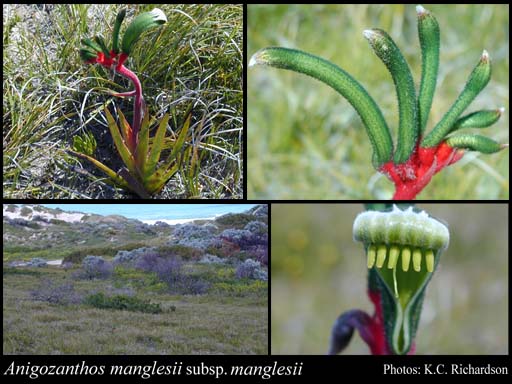- Conservation Code
- Not threatened
- Naturalised Status
- Native to Western Australia
- Name Status
- Current
Rhizomatous, perennial, herb, 0.2-1.1 m high. Fl. green&red, Aug to Nov. White, yellow or grey sand, sandy loam.

Scientific Description
Leaves flat, 140-610 mm long, 6-13 mm wide; bristles or hairs on the leaf margin absent; hairs on the surface of the leaf absent (leaf surfaces glabrous). Scape present, hairy, 480-770 mm long. Inflorescence subtended by a bract 15-25 mm long, with several flowers; floral bracts 14-20 mm long; pedicels present, 8-14 mm long; flowers 75-80 mm long. Perianth hairy, bilaterally symmetric, distinctly bicoloured, red and green, with six more or less equal tepals, the inner segments 10-11 mm long. Stamens six, in one level; filaments 2-2.5 mm long; anther 8-9 mm long, without an appendage. Style 70-72 mm long. Flowers in August, September, October or November. Occurs in the Swan Coastal Plain, Avon Wheatbelt, Jarrah Forest and Warren IBRA bioregion(s), of the South-west Botanical Province.
Distribution
- IBRA Regions
- Avon Wheatbelt, Jarrah Forest, Swan Coastal Plain, Warren.
- IBRA Subregions
- Dandaragan Plateau, Katanning, Northern Jarrah Forest, Perth, Southern Jarrah Forest, Warren.
- Local Government Areas (LGAs)
- Armadale, Augusta Margaret River, Bayswater, Boddington, Boyup Brook, Bridgetown-Greenbushes, Broomehill-Tambellup, Bunbury, Busselton, Cambridge, Collie, Cranbrook, Donnybrook-Balingup, Gingin, Gosnells, Harvey, Kalamunda, Kojonup, Kwinana, Mandurah, Melville, Mundaring, Murray, Nannup, Perth, Serpentine-Jarrahdale, South Perth, Stirling, Swan, Toodyay, Wanneroo, Waroona, York.